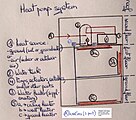Off-the-grid
The term off-grid refers to not being connected to a grid, mainly used in terms of not being connected to the main or national transmission grid in electricity. In electricity off-grid can be stand alone systems(SHS) or mini-grids typically to provide a smaller community with electricity. Off-grid electrification is an approach to access electricity used in countries and areas with little access to electricity, due to scattered or distant population. It can be any kind of electricity generation.
The term off-the-grid (OTG) can refer to living in a self-sufficient manner without reliance on one or more public utilities.
Off-the-grid homes are autonomous; they do not rely on municipal water supply, sewer, natural gas, electrical power grid, or similar utility services. A true off-grid house is able to operate completely independently of all traditional public utility services. The idea has been recently popularized by certain celebrities including Ed Begley, Jr.[1] who stars in Living with Ed[2] television show on the Home & Garden Television network. Actress Daryl Hannah promotes off-grid living and constructed her home in Colorado according to those principles, as does survival expert and co-star of Dual Survival, Cody Lundin[3]
Electrical power
Electrical power can be generated on-site with renewable energy sources such as solar, wind or geothermal; with a generator and adequate fuel reserves; or simply done without, as in Amish and Old Order Mennonite communities. Such a system is called a stand-alone power system.
Water
On-site water sources can include a well, stream, or lake. Depending on the water source, this may include pumps and/or filtration. Rainwater can also be harvested.
Popularity
On 13 April 2006, USA Today reported that there were "some 180,000 families living off-grid, a figure that has jumped 33% a year for a decade," and cited Richard Perez, publisher of Home Power Magazine,[4] as the source.[5] Assuming the same rate of growth, there would be a quarter million off-grid households in the United States by late 2007. Because many Third World citizens have never had the chance to go on the grid, current estimates are that 1.7 billion people live off-grid worldwide.[6]
Environmental impact
The State of California is encouraging solar and wind power generation that is connected to the electrical grid to avoid the use of toxic lead acid batteries for night time storage.[7] Grid-tie systems are more expensive due to the extra hardware costs (such as a grid-tie inverter) especially when old car batteries that can no longer supply enough current to start a car are reused.[8]
Going off-grid can be done for altruistic reasons or to lower the environmental impact of living, as the typically limited amount of on-site renewable energy available is an incentive to reduce its use. But if energy usage is not reduced, going off-grid actually has a larger environmental impact versus using the grid, due to the lower efficiencies of the components. It is often done to residential buildings only occasionally occupied, such as vacation cabins, to avoid high initial costs of traditional utility connections. Other persons choose to live in houses where the cost of outside utilities is prohibitive, or such a distance away as to be impractical. In his book "How to live off-grid" Nick Rosen lists seven reasons for going off-grid. The top two are saving money, and reducing the carbon footprint. Others include survivalists, preparing for the collapse of the oil economy and bringing life back to the countryside.
Economic consideration
In situations where grid parity has been reached, it becomes cheaper to generate one's own electricity rather than purchasing it from the grid. This depends on equipment costs, the availability of renewable energy sources (wind, sun), and the cost of a grid connection. For example, in certain remote areas a grid connection would be prohibitively expensive, resulting in grid parity being reached immediately.
Africa
In Africa, small inexpensive Chinese-made solar electric systems became available, and as of 2010, they were being installed on mudhuts in villages in Kenya, and other countries. Inexpensive solar panels and LED lights make the systems affordable.[9]
See also
Gallery
-
Incomplete DIY Wind generator system
-
A PV-solar system
-
Schematic of an active solar heating system
-
A HVAC heat pump system
-
Treatment ponds can be used for purifying water
-
Heat and cold storage may be combined with heat pumps for use in the domestic greenhouse or to heat the house itself
References
- ^ TheRenewablePlanet.com
- ^ livingwithed.net
- ^ off-grid.net
- ^ Home Power Magazine
- ^ USA Today
- ^ Modern Ghana News
- ^ California Solar Energy (PV) Rebate Information: The New California Solar Initiative Program
- ^ African Town Gets Wind Power and Knowledge
- ^ Elisabeth Rosenthal (December 24, 2010). "African Huts Far From the Grid Glow With Renewable Power". The New York Times. Retrieved December 25, 2010.






